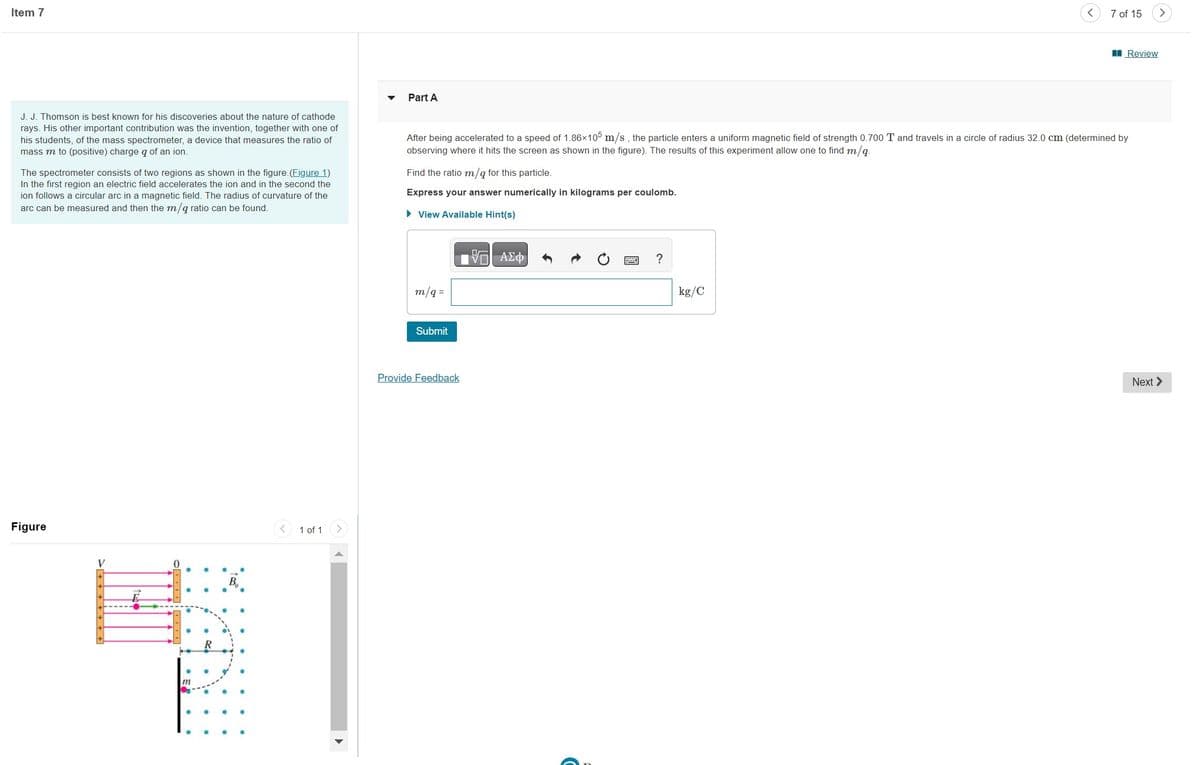J. J. Thomson is best known for his discoveries about the nature of cathode rays. His other important contribution was the invention, together with one of his students, of the mass spectrometer, a device that measures the ratio of mass m to (positive) charge q of an ion The spectrometer consists of two regions as shown in the figure (Eigure 1) In the first region an electric field accelerates the ion and in the second the ion follows a circular arc in a magnetic field. The radius of curvature of the arc can be measured and then the m/q ratio can be found. ▼ Part A After being accelerated to a speed of 1.86x105 m/s, the particle enters a uniform magnetic field of strength 0.700 T and travels in a circle of radius 32.0 cm (determined by observing where it hits the screen as shown in the figure). The results of this experiment allow one to find m/q Find the ratio m/q for this particle. Express your answer numerically in kilograms per coulomb. ▸ View Available Hint(s) m/q= Submit ——| ΑΣΦ Provide Feedback → SMK ? Review kg/C Next >
J. J. Thomson is best known for his discoveries about the nature of cathode rays. His other important contribution was the invention, together with one of his students, of the mass spectrometer, a device that measures the ratio of mass m to (positive) charge q of an ion The spectrometer consists of two regions as shown in the figure (Eigure 1) In the first region an electric field accelerates the ion and in the second the ion follows a circular arc in a magnetic field. The radius of curvature of the arc can be measured and then the m/q ratio can be found. ▼ Part A After being accelerated to a speed of 1.86x105 m/s, the particle enters a uniform magnetic field of strength 0.700 T and travels in a circle of radius 32.0 cm (determined by observing where it hits the screen as shown in the figure). The results of this experiment allow one to find m/q Find the ratio m/q for this particle. Express your answer numerically in kilograms per coulomb. ▸ View Available Hint(s) m/q= Submit ——| ΑΣΦ Provide Feedback → SMK ? Review kg/C Next >
Glencoe Physics: Principles and Problems, Student Edition
1st Edition
ISBN:9780078807213
Author:Paul W. Zitzewitz
Publisher:Paul W. Zitzewitz
Chapter28: The Atom
Section: Chapter Questions
Problem 63A
Related questions
Question
100%

Transcribed Image Text:Item 7
J. J. Thomson is best known for his discoveries about the nature of cathode
rays. His other important contribution was the invention, together with one of
his students, of the mass spectrometer, a device that measures the ratio of
mass m to (positive) charge q of an ion.
The spectrometer consists of two regions as shown in the figure. (Figure 1)
In the first region an electric field accelerates the ion and in the second the
ion follows a circular arc in a magnetic field. The radius of curvature of the
arc can be measured and then the m/q ratio can be found.
Figure
0
HANI
1 of 1
Part A
Find the ratio m/q for this particle.
Express your answer numerically in kilograms per coulomb.
► View Available Hint(s)
After being accelerated to a speed of 1.86×105 m/s, the particle enters a uniform magnetic field of strength 0.700 T and travels in a circle of radius 32.0 cm (determined by
observing where it hits the screen as shown in the figure). The results of this experiment allow one to find m/q.
m/q=
Submit
Provide Feedback
—| ΑΣΦ
?
7 of 15
kg/C
Review
Next >
Expert Solution
This question has been solved!
Explore an expertly crafted, step-by-step solution for a thorough understanding of key concepts.
This is a popular solution!
Trending now
This is a popular solution!
Step by step
Solved in 3 steps

Knowledge Booster
Learn more about
Need a deep-dive on the concept behind this application? Look no further. Learn more about this topic, physics and related others by exploring similar questions and additional content below.Recommended textbooks for you

Glencoe Physics: Principles and Problems, Student…
Physics
ISBN:
9780078807213
Author:
Paul W. Zitzewitz
Publisher:
Glencoe/McGraw-Hill

College Physics
Physics
ISBN:
9781938168000
Author:
Paul Peter Urone, Roger Hinrichs
Publisher:
OpenStax College

Glencoe Physics: Principles and Problems, Student…
Physics
ISBN:
9780078807213
Author:
Paul W. Zitzewitz
Publisher:
Glencoe/McGraw-Hill

College Physics
Physics
ISBN:
9781938168000
Author:
Paul Peter Urone, Roger Hinrichs
Publisher:
OpenStax College